For already more than 200 years, Amatller chocolates are produced in the Spanish city of Barcelona. Since 1797, Chocolate Amatller has used a great variety of advertising messages. In 1972, Chocolate Simón Coll bought Amatller, and it still produces various Amattler boxes and tins with chocolates. Between the end of the 19th Century and the first half of the 20th, Amatller published collectors cards to promote and market their chocolates. The Spanish chocolaterie presented several series of cards that dealt with films and film stars. Earlier we did posts on sets with tinted black and white cards for the Italian silent films Tosca (Alfredo De Antoni, 1918) and Fabiola (Enrico Guazzoni, 1918). Today, EFSP presents a selection of the series 'Collecciones Amatller' with colourful cards from the early 1920s with both American and European film stars and film scenes.

Spanish collectors card in the Collecciones Amatller Series, Serie A, artist no. 1 and 2, no. 8, by Chocolate Amatller.
Mary Pickford (1892-1979) was a legendary silent film actress and was known as 'America’s sweetheart.' She was the co-founder of United Artists and helped establish the AMPAS (Academy of Motion Pictures and Sciences). American actor Douglas Fairbanks (1883-1939) was best known for his swashbuckling roles in silent films such as The Mark of Zorro (1920), Robin Hood (1922), and The Thief of Bagdad (1924), but spent the early part of his career making comedies. Fairbanks was a founding member of United Artists and of The Motion Picture Academy. He hosted the first Oscars Ceremony in 1929. With his marriage to Mary Pickford in 1920, the couple became Hollywood royalty and Fairbanks was referred to as 'The King of Hollywood', but his career rapidly declined with the advent of the 'talkies'. He made his final film in Great Britain, The Private Life of Don Juan (1934).

Spanish collectors card in the Collecciones Amatller Series, Serie B, artist no. 3, no. 10, by Chocolate Amatller.
David Wark Griffith (1875–1948) was an American director, writer, and producer who pioneered modern cinematic techniques. After shooting hundreds of shorts at Biograph, he made his mark with his features The Birth of a Nation (1915) and Intolerance (1916), both acclaimed for their radical camera and narrative techniques, while the first has also been condemned for its inherently racist philosophy. Several of Griffith's later films were also successful, including Broken Blossoms (1919), Way Down East (1920), and Orphans of the Storm (1921), but his high costs for production, promotion, and roadshow often made his ventures commercial failures. Griffith was one of the co-founders of United Artists and of AMPAS (Academy of Motion Pictures and Sciences).

Spanish collectors card in the Collecciones Amatller Series, Series C, artist no. 4, no. 13, by Chocolate Amatller. Photo: Pola Negri and Harry Liedtke in the German silent film Sumurun (Ernst Lubitsch, 1920).
Ernst Lubitsch's silent film Sumurun tells the story of the favourite slave girl (Jenny Hasselquist) of a tyrannical sheik (Paul Wegener), who falls in love with a cloth merchant (Harry Liedtke). Meanwhile, a hunchback clown (Ernst Lubitsch himself) suffers unrequited love for a travelling dancer (Pola Negri) who wants to join the harem. Polish film actress Pola Negri (1897-1987) achieved notoriety as a femme fatale in German and American silent films between the 1910s and 1930s. German actor Harry Liedtke (1882-1945) was the charming ladykiller of many early silent classics. Detective serials like Joe Deebs made him one of the first male stars of the German cinema.

Spanish collectors card in the Collecciones Amatller Series, Series C, artist no. 4, no. 18, by Chocolate Amatller. Photo: Pola Negri, Antonio Moreno and director Herbert Brenon while shooting the silent film The Spanish Dancer (Herbert Brenon, 1923).
Polish film actress Pola Negri (1897-1987) achieved notoriety as a femme fatale in German and American silent films between the 1910s and 1930s. Antonio 'Tony' Moreno (1887-1967) was a Spanish-born American actor and film director of the silent film era and through the 1950s. In his early films, Moreno was often typecast as the 'Latin Lover'. He is best known for films such as The Spanish Dancer (1923), Mare Nostrum (1926) with Alice Terry, The Temptress (1926) with Greta Garbo, and It (1927) with Clara Bow.

Spanish collectors card in the Collecciones Amatller Series, Series CC, artist 35, no. 77, by Chocolate Amatller. Photo: Wallace Reid and Harrison Ford in Hawthorne of the U.S.A. (James Cruze, 1919). It is one of the few surviving films with Reid.
Wallace Reid (1891–1923) was an American actor in silent film referred to as "the screen's most perfect lover". Born in a vaudeville family, he became an all-around athlete and gifted musician. When his father entered the film business in 1910, he brought along his teenage son, who debuted at Selig but soon rose to popularity at Vitagraph. After some 100 shorts and parts in films like Birth of a nation and Intolerance by Griffith, Paramount hired him for some 60 more films, including some dashing fast car films (Reid was so fond of racing, he even joined an Indianapolis race). By the 1920s, Reid was one of Hollywood's major heartthrobs. En route to Oregon for a film shooting in 1919, he was injured in a train wreck and took morphine to continue filming. This led to an addiction, which in the end killed him, in 1923, at the age of only 31. His wife, the actress Dorothy Davenport, afterwards, did a national tour to warn against the dangers of drugs.
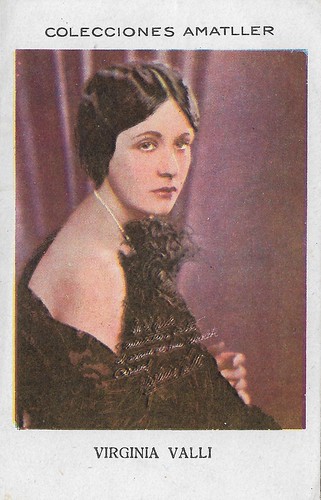
Spanish collectors card in the Collecciones Amatller Series, Series CCC, artist no. 69, no. 123, by Chocolate Amatller.
Virginia Valli (1895–1968) was an American stage and film actress whose motion picture career started in the silent film era and lasted until the beginning of the sound film era of the 1930s.
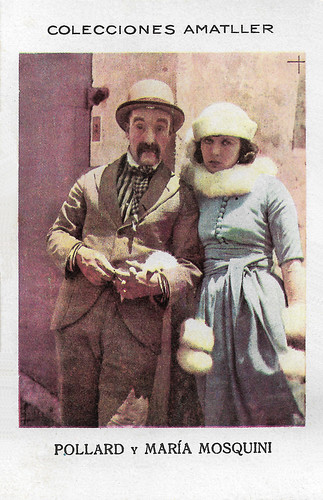
Spanish collectors card in the Collecciones Amatller Series, Serie CH, artist no. 6, no. 21, by Chocolate Amatller.
Australian born comedian Snub Pollard (1889-1962) with his walrus moustache was one of the well known faces of the Hal Roach company during the 1910s. His inseparable leading lady in many Hal Roach comedies was pert, slightly-built comedienne Maria Mosquini (1899-1983).
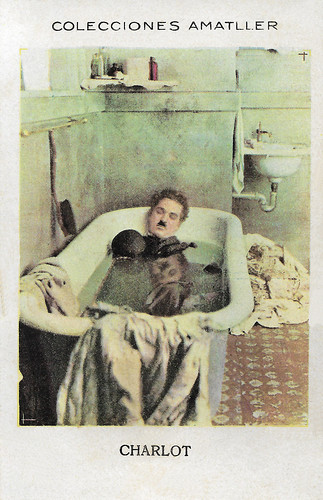
Spanish collectors card in the Collecciones Amatller Series, Serie D, artist no. 7, no. 26, by Chocolate Amatller. Photo: Charlie Chaplin in Pay Day (Charles Chaplin, 1922).
English comedian Charles ‘Charlie’ Chaplin (1889-1977) was one of the most creative and influential personalities of the silent-film era. His most famous role was that of The Tramp with his toothbrush moustache, undersized bowler hat and bamboo cane who struggled to survive while keeping his dignity in a world with great social injustice. Chaplin used mime, slapstick and other visual comedy routines, and he not only starred in his films, but also directed, wrote and produced them, and composed the music as well. His working life in entertainment spanned over 75 years, from the Victorian stage and the Music Hall in the United Kingdom as a child performer, until close to his death at the age of 88. Author George Bernard Shaw called Chaplin "the only genius to come out of the movie industry".

Spanish collectors card in the Collecciones Amatller Series, Series EE, artist no. 40, no. 82, by Chocolate Amatller.
Irish born Rex Ingram (1892-1950) was a film director, producer, writer and actor in Hollywood who was responsible for a succession of silent films for Metro Pictures, later M-G-M, that topped the box office and were hailed as masterpieces by the critics. He made a star of Rudolph Valentino with The Four Horsemen of the Apocalypse (1921). When they fell out, he found a new heartthrob in Ramon Novarro, who debuted with Ingram in The Prisoner of Zenda (1922). Rex’s second marriage, to Alice Terry, saw him cast her in the lead in all but one of his films. Director Erich von Stroheim once called him "the world's greatest director".

Spanish collectors card in the Collecciones Amatller Series, Series EE, artist no. 41, no. 83, by Chocolate Amatller. Photo: Lewis Stone in The Prisoner of Zenda (Rex Ingram, 1922).
Lewis Stone (1879–1953) was an American movie actor best known for his role as Judge James Hardy in the MGM Andy Hardy film series (1937-1946) and as a studio contract player. Stone had started acting in films in the mid-1910s. He was nominated for the Academy Award for Best Actor in 1929 for The Patriot. He appeared in seven films with Greta Garbo, including Grand Hotel (1932) and Queen Christina (1933), and also had a major part as the Warden in the Pre-Code movie The Big House (1930). After The Prisoner of Zenda, Stone did two more films with Rex Ingram: Trifling Women (1922) with Barbara La Marr and Ramon Novarro, and Scaramouche (1923) with Novarro and Alice Terry. Oddly enough two of his last parts were in remakes of Scaramouche and The Prisoner of Zenda, both 1952.

Spanish collectors card in the Collecciones Amatller Series, Series G, artist no. 10, no. 32, by Chocolate Amatller.
J. (Jack) Warren Kerrigan (1879-1947) was an American actor of the silent screen. From 1910, he had a most active career first in shorts at Essanay, American at Victor, then in features at Universal. After a gap in the early 1920s, he came back with a bang in James Cruze's The Covered Wagon (1923) but stopped acting in 1924 after a car accident.
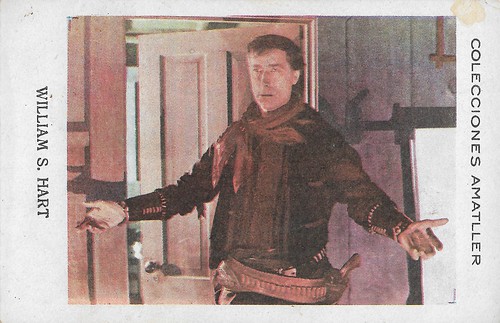
Spanish collectors card in the Collecciones Amatller Series, Series HH, artist no. 44, no. 87, by Chocolate Amatller. Photo: Amattler.
William S. [Surrey] Hart (1864–1946) was an American silent film actor, screenwriter, director, and producer. He entered films in 1914 where, after playing supporting roles in two short films, he achieved stardom as the lead in The Bargain (Reginald Barker, 1914), his first Western. He became a foremost Western star of the silent era who played characters with honour and integrity. Hart was particularly interested in making realistic Westerns, and his films are noted for their authentic costumes and props. Hart also had an extraordinary acting ability, honed on Shakespearean theatre stages in the United States and the UK.
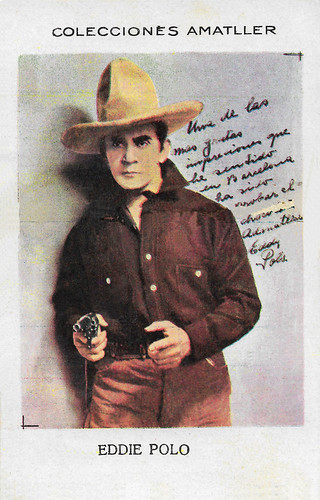
Spanish collectors card in the Collecciones Amatller Series, Serie I, Artista no. 12, no. 34, by Chocolate Amatller. Photo: Amattler.
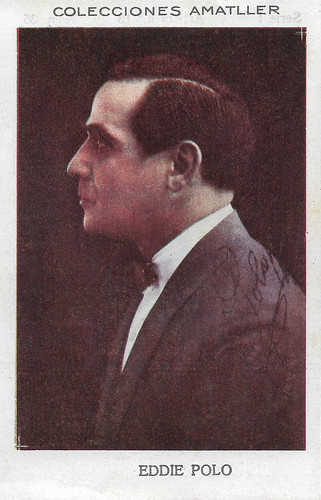
Spanish collectors card in the Collecciones Amatller Series, Serie I, artist no. 12, no. 35, by Chocolate Amatller. Photo: Amatller.

Spanish collectors card in the Collecciones Amatller Series, Series I, artist no. 12, no. 36, by Chocolate Amatller.
Eddie Polo (1875–1961) was an Austro-American actor of the silent era. He was born Edward W. Wyman or Weimer in Vienna, Austria-Hungary. With his brother Sam, he was the trapeze act The Flying Cordovas. He was the first man to parachute off the Eiffel Tower. Beginning in 1913, he appeared in serials and films in the USA and as Cyclone Smith, he became a popular Western hero. During the late 1920s, he was an action star in the German silent cinema. After his acting career ended in the mid-1940s he worked as a makeup artist.

Spanish collectors card in the Collecciones Amatller Series, Series J, artist no. 13, no. 39, by Chocolate Amatller. Photo: Wallace Beery in Bavu (Stuart Paton, 1923).
American actor Wallace Beery (1885-1949) is best known for his portrayal of Bill in Min and Bill opposite Marie Dressler, as Long John Silver in Treasure Island, as Pancho Villa in Viva Villa!, and his titular role in The Champ, for which he won the Academy Award for Best Actor. Beery appeared in some 250 films in a 36-year career. He was the brother of actor Noah Beery, Sr. and uncle of actor Noah Beery, Jr.

Spanish collectors card in the Collecciones Amatller Series, Series KK, artist no. 48, no. 94, by Chocolate Amatller.
Marion Davies (1897-1961) was one of the great comedic actresses of the silent era. She starred in nearly four dozen films between 1917 and 1937.

Spanish collectors card in the Collecciones Amatller Series, Series M., artist 17, no. 48, by Chocolate Amatller.
Thomas Meighan and the Spanish writer Vicente Blasco Ibáñez. The latter was the author of 'The Four Horsemen of the Apocalypse', 'Mare Nostrum', 'The Torrent', 'The Temptress', and 'Blood and Sand', all filmed in Hollywood in the 1920s, even if not with Meighan.

Spanish collectors card in the Collecciones Amatller Series, Series N, artist 19, no. 50, by Chocolate Amatller. Photo: Charles de Roche[fort] in Law of the Lawless (Victor Fleming, 1923).
Charles de Rochefort (1887-1952) was a star of the French silent cinema. He appeared in 34 films between 1911 and 1932. In 1923 he went to the US, where he was known as Charles de Roche and starred in several films in Hollywood, e.g. as Pharaoh Rameses in The Ten Commandments (DeMille 1923). After his return to France, he became a film director of sound films.

Spanish collectors card in the Collecciones Amatller Series, Series NN, artist no. 54, no. 100, by Chocolate Amatller.
Julia Faye (1892–1966) was an American film actress. Her career is inextricably linked to director Cecil B. DeMille. He was her mentor, while she was for many years his mistress. Their liaison was tolerated by De Mille's long-suffering wife Constance Adams. She was featured in billed supporting roles in a number of De Mille's big-budget extravaganzas, including The Ten Commandments (1923) (as Pharaoh's wife), The Volga Boatsman (1926) (as a gypsy) and The King of Kings (1927) (as Martha).
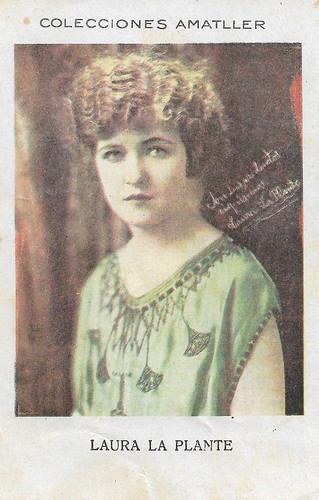
Spanish collectors card in the Collecciones Amatller Series, Series Q, artist 22, no. 54, by Chocolate Amatller.
Laura La Plante (born Laura LaPlant, 1904–1996) was an American actress, best known for her work in the silent film era, such as Smouldering Fires (Clarence Brown, 1925) with Pauline Frederick, Skinner's Dress Suit (William Seiter, 1926) with Reginald Denny, and The Cat and the Canary (Paul Leni, 1927) with Creighton Hale. In the 1920s she acted in over 60 films, mostly for Universal, including the two part-talkies The Love Trap (William Wyler, 1929) and Showboat (Harry A. Pollard, 1929).

Spanish collectors card in the Collecciones Amatller Series, Series QQ, artist no. 58, no. 106, by Chocolate Amatller.
Norma Talmadge (1894–1957) was an American actress and film producer of the silent era. A major box-office draw for more than a decade, her career reached a peak in the early 1920s, when she ranked among the most popular idols of the American screen.

Spanish collectors card in the Collecciones Amatller Series, Series QQ, artist no. 58, no. 107, by Chocolate Amatller. Photo: Norma Talmadge and Lowell Sherman in Yes or No? (Roy William Neill, 1920).
Norma Talmadge (1894–1957) was an American actress and film producer of the silent era. A major box-office draw for more than a decade, her career reached a peak in the early 1920s, when she ranked among the most popular idols of the American screen.

Spanish collectors card in the Collecciones Amatller Series, Series R, artist 23, no. 55, by Chocolate Amatller.
Rudolph Valentino (1895-1926) was Hollywood's ultimate 'Latin Lover'. The Italian-born American actor starred in several well-known silent films including The Four Horsemen of the Apocalypse (1921), The Sheik (1922), Blood and Sand (1922), The Eagle (1925), and The Son of the Sheik (1926). His early death at age 31 caused mass hysteria among his female fans and propelled him into iconic status.
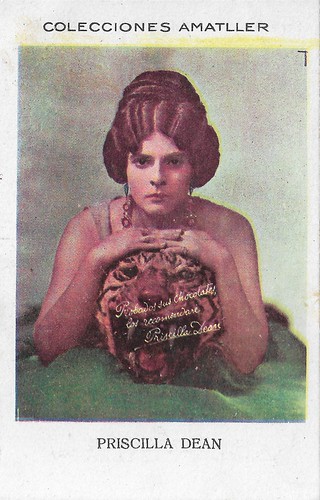
Spanish collectors card in the Collecciones Amatller Series, Series S, artist 24, no. 58, by Chocolate Amatller.
Priscilla Dean (1896-1987) was an American actress of the silent screen.
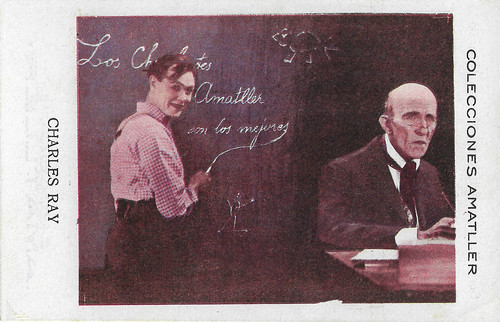
Spanish collectors card in the Collecciones Amatller Series, Serie X, artist no. 28, no. 63, by Chocolate Amatller. Photo: United Artists. Charles Ray and Lon Poff in The Old Swimmin' Hole (Joe de Grasse, 1921).
Charles Ray (1891-1943) was an American actor, scriptwriter, and director of the silent screen, who knew a parabola from rags to riches and back again. He worked for Paramount, his own company, United Artists and MGM. In the late 1910s and early 1920s, he was a very popular actor and one of Hollywood's best-paid stars.

Spanish collectors card in the Collecciones Amatller Series, Serie A, artist no. 1 and 2, no. 8, by Chocolate Amatller.
Mary Pickford (1892-1979) was a legendary silent film actress and was known as 'America’s sweetheart.' She was the co-founder of United Artists and helped establish the AMPAS (Academy of Motion Pictures and Sciences). American actor Douglas Fairbanks (1883-1939) was best known for his swashbuckling roles in silent films such as The Mark of Zorro (1920), Robin Hood (1922), and The Thief of Bagdad (1924), but spent the early part of his career making comedies. Fairbanks was a founding member of United Artists and of The Motion Picture Academy. He hosted the first Oscars Ceremony in 1929. With his marriage to Mary Pickford in 1920, the couple became Hollywood royalty and Fairbanks was referred to as 'The King of Hollywood', but his career rapidly declined with the advent of the 'talkies'. He made his final film in Great Britain, The Private Life of Don Juan (1934).

Spanish collectors card in the Collecciones Amatller Series, Serie B, artist no. 3, no. 10, by Chocolate Amatller.
David Wark Griffith (1875–1948) was an American director, writer, and producer who pioneered modern cinematic techniques. After shooting hundreds of shorts at Biograph, he made his mark with his features The Birth of a Nation (1915) and Intolerance (1916), both acclaimed for their radical camera and narrative techniques, while the first has also been condemned for its inherently racist philosophy. Several of Griffith's later films were also successful, including Broken Blossoms (1919), Way Down East (1920), and Orphans of the Storm (1921), but his high costs for production, promotion, and roadshow often made his ventures commercial failures. Griffith was one of the co-founders of United Artists and of AMPAS (Academy of Motion Pictures and Sciences).

Spanish collectors card in the Collecciones Amatller Series, Series C, artist no. 4, no. 13, by Chocolate Amatller. Photo: Pola Negri and Harry Liedtke in the German silent film Sumurun (Ernst Lubitsch, 1920).
Ernst Lubitsch's silent film Sumurun tells the story of the favourite slave girl (Jenny Hasselquist) of a tyrannical sheik (Paul Wegener), who falls in love with a cloth merchant (Harry Liedtke). Meanwhile, a hunchback clown (Ernst Lubitsch himself) suffers unrequited love for a travelling dancer (Pola Negri) who wants to join the harem. Polish film actress Pola Negri (1897-1987) achieved notoriety as a femme fatale in German and American silent films between the 1910s and 1930s. German actor Harry Liedtke (1882-1945) was the charming ladykiller of many early silent classics. Detective serials like Joe Deebs made him one of the first male stars of the German cinema.

Spanish collectors card in the Collecciones Amatller Series, Series C, artist no. 4, no. 18, by Chocolate Amatller. Photo: Pola Negri, Antonio Moreno and director Herbert Brenon while shooting the silent film The Spanish Dancer (Herbert Brenon, 1923).
Polish film actress Pola Negri (1897-1987) achieved notoriety as a femme fatale in German and American silent films between the 1910s and 1930s. Antonio 'Tony' Moreno (1887-1967) was a Spanish-born American actor and film director of the silent film era and through the 1950s. In his early films, Moreno was often typecast as the 'Latin Lover'. He is best known for films such as The Spanish Dancer (1923), Mare Nostrum (1926) with Alice Terry, The Temptress (1926) with Greta Garbo, and It (1927) with Clara Bow.

Spanish collectors card in the Collecciones Amatller Series, Series CC, artist 35, no. 77, by Chocolate Amatller. Photo: Wallace Reid and Harrison Ford in Hawthorne of the U.S.A. (James Cruze, 1919). It is one of the few surviving films with Reid.
Wallace Reid (1891–1923) was an American actor in silent film referred to as "the screen's most perfect lover". Born in a vaudeville family, he became an all-around athlete and gifted musician. When his father entered the film business in 1910, he brought along his teenage son, who debuted at Selig but soon rose to popularity at Vitagraph. After some 100 shorts and parts in films like Birth of a nation and Intolerance by Griffith, Paramount hired him for some 60 more films, including some dashing fast car films (Reid was so fond of racing, he even joined an Indianapolis race). By the 1920s, Reid was one of Hollywood's major heartthrobs. En route to Oregon for a film shooting in 1919, he was injured in a train wreck and took morphine to continue filming. This led to an addiction, which in the end killed him, in 1923, at the age of only 31. His wife, the actress Dorothy Davenport, afterwards, did a national tour to warn against the dangers of drugs.

Spanish collectors card in the Collecciones Amatller Series, Series CCC, artist no. 69, no. 123, by Chocolate Amatller.
Virginia Valli (1895–1968) was an American stage and film actress whose motion picture career started in the silent film era and lasted until the beginning of the sound film era of the 1930s.

Spanish collectors card in the Collecciones Amatller Series, Serie CH, artist no. 6, no. 21, by Chocolate Amatller.
Australian born comedian Snub Pollard (1889-1962) with his walrus moustache was one of the well known faces of the Hal Roach company during the 1910s. His inseparable leading lady in many Hal Roach comedies was pert, slightly-built comedienne Maria Mosquini (1899-1983).

Spanish collectors card in the Collecciones Amatller Series, Serie D, artist no. 7, no. 26, by Chocolate Amatller. Photo: Charlie Chaplin in Pay Day (Charles Chaplin, 1922).
English comedian Charles ‘Charlie’ Chaplin (1889-1977) was one of the most creative and influential personalities of the silent-film era. His most famous role was that of The Tramp with his toothbrush moustache, undersized bowler hat and bamboo cane who struggled to survive while keeping his dignity in a world with great social injustice. Chaplin used mime, slapstick and other visual comedy routines, and he not only starred in his films, but also directed, wrote and produced them, and composed the music as well. His working life in entertainment spanned over 75 years, from the Victorian stage and the Music Hall in the United Kingdom as a child performer, until close to his death at the age of 88. Author George Bernard Shaw called Chaplin "the only genius to come out of the movie industry".

Spanish collectors card in the Collecciones Amatller Series, Series EE, artist no. 40, no. 82, by Chocolate Amatller.
Irish born Rex Ingram (1892-1950) was a film director, producer, writer and actor in Hollywood who was responsible for a succession of silent films for Metro Pictures, later M-G-M, that topped the box office and were hailed as masterpieces by the critics. He made a star of Rudolph Valentino with The Four Horsemen of the Apocalypse (1921). When they fell out, he found a new heartthrob in Ramon Novarro, who debuted with Ingram in The Prisoner of Zenda (1922). Rex’s second marriage, to Alice Terry, saw him cast her in the lead in all but one of his films. Director Erich von Stroheim once called him "the world's greatest director".

Spanish collectors card in the Collecciones Amatller Series, Series EE, artist no. 41, no. 83, by Chocolate Amatller. Photo: Lewis Stone in The Prisoner of Zenda (Rex Ingram, 1922).
Lewis Stone (1879–1953) was an American movie actor best known for his role as Judge James Hardy in the MGM Andy Hardy film series (1937-1946) and as a studio contract player. Stone had started acting in films in the mid-1910s. He was nominated for the Academy Award for Best Actor in 1929 for The Patriot. He appeared in seven films with Greta Garbo, including Grand Hotel (1932) and Queen Christina (1933), and also had a major part as the Warden in the Pre-Code movie The Big House (1930). After The Prisoner of Zenda, Stone did two more films with Rex Ingram: Trifling Women (1922) with Barbara La Marr and Ramon Novarro, and Scaramouche (1923) with Novarro and Alice Terry. Oddly enough two of his last parts were in remakes of Scaramouche and The Prisoner of Zenda, both 1952.

Spanish collectors card in the Collecciones Amatller Series, Series G, artist no. 10, no. 32, by Chocolate Amatller.
J. (Jack) Warren Kerrigan (1879-1947) was an American actor of the silent screen. From 1910, he had a most active career first in shorts at Essanay, American at Victor, then in features at Universal. After a gap in the early 1920s, he came back with a bang in James Cruze's The Covered Wagon (1923) but stopped acting in 1924 after a car accident.

Spanish collectors card in the Collecciones Amatller Series, Series HH, artist no. 44, no. 87, by Chocolate Amatller. Photo: Amattler.
William S. [Surrey] Hart (1864–1946) was an American silent film actor, screenwriter, director, and producer. He entered films in 1914 where, after playing supporting roles in two short films, he achieved stardom as the lead in The Bargain (Reginald Barker, 1914), his first Western. He became a foremost Western star of the silent era who played characters with honour and integrity. Hart was particularly interested in making realistic Westerns, and his films are noted for their authentic costumes and props. Hart also had an extraordinary acting ability, honed on Shakespearean theatre stages in the United States and the UK.

Spanish collectors card in the Collecciones Amatller Series, Serie I, Artista no. 12, no. 34, by Chocolate Amatller. Photo: Amattler.

Spanish collectors card in the Collecciones Amatller Series, Serie I, artist no. 12, no. 35, by Chocolate Amatller. Photo: Amatller.

Spanish collectors card in the Collecciones Amatller Series, Series I, artist no. 12, no. 36, by Chocolate Amatller.
Eddie Polo (1875–1961) was an Austro-American actor of the silent era. He was born Edward W. Wyman or Weimer in Vienna, Austria-Hungary. With his brother Sam, he was the trapeze act The Flying Cordovas. He was the first man to parachute off the Eiffel Tower. Beginning in 1913, he appeared in serials and films in the USA and as Cyclone Smith, he became a popular Western hero. During the late 1920s, he was an action star in the German silent cinema. After his acting career ended in the mid-1940s he worked as a makeup artist.

Spanish collectors card in the Collecciones Amatller Series, Series J, artist no. 13, no. 39, by Chocolate Amatller. Photo: Wallace Beery in Bavu (Stuart Paton, 1923).
American actor Wallace Beery (1885-1949) is best known for his portrayal of Bill in Min and Bill opposite Marie Dressler, as Long John Silver in Treasure Island, as Pancho Villa in Viva Villa!, and his titular role in The Champ, for which he won the Academy Award for Best Actor. Beery appeared in some 250 films in a 36-year career. He was the brother of actor Noah Beery, Sr. and uncle of actor Noah Beery, Jr.

Spanish collectors card in the Collecciones Amatller Series, Series KK, artist no. 48, no. 94, by Chocolate Amatller.
Marion Davies (1897-1961) was one of the great comedic actresses of the silent era. She starred in nearly four dozen films between 1917 and 1937.

Spanish collectors card in the Collecciones Amatller Series, Series M., artist 17, no. 48, by Chocolate Amatller.
Thomas Meighan and the Spanish writer Vicente Blasco Ibáñez. The latter was the author of 'The Four Horsemen of the Apocalypse', 'Mare Nostrum', 'The Torrent', 'The Temptress', and 'Blood and Sand', all filmed in Hollywood in the 1920s, even if not with Meighan.

Spanish collectors card in the Collecciones Amatller Series, Series N, artist 19, no. 50, by Chocolate Amatller. Photo: Charles de Roche[fort] in Law of the Lawless (Victor Fleming, 1923).
Charles de Rochefort (1887-1952) was a star of the French silent cinema. He appeared in 34 films between 1911 and 1932. In 1923 he went to the US, where he was known as Charles de Roche and starred in several films in Hollywood, e.g. as Pharaoh Rameses in The Ten Commandments (DeMille 1923). After his return to France, he became a film director of sound films.

Spanish collectors card in the Collecciones Amatller Series, Series NN, artist no. 54, no. 100, by Chocolate Amatller.
Julia Faye (1892–1966) was an American film actress. Her career is inextricably linked to director Cecil B. DeMille. He was her mentor, while she was for many years his mistress. Their liaison was tolerated by De Mille's long-suffering wife Constance Adams. She was featured in billed supporting roles in a number of De Mille's big-budget extravaganzas, including The Ten Commandments (1923) (as Pharaoh's wife), The Volga Boatsman (1926) (as a gypsy) and The King of Kings (1927) (as Martha).

Spanish collectors card in the Collecciones Amatller Series, Series Q, artist 22, no. 54, by Chocolate Amatller.
Laura La Plante (born Laura LaPlant, 1904–1996) was an American actress, best known for her work in the silent film era, such as Smouldering Fires (Clarence Brown, 1925) with Pauline Frederick, Skinner's Dress Suit (William Seiter, 1926) with Reginald Denny, and The Cat and the Canary (Paul Leni, 1927) with Creighton Hale. In the 1920s she acted in over 60 films, mostly for Universal, including the two part-talkies The Love Trap (William Wyler, 1929) and Showboat (Harry A. Pollard, 1929).

Spanish collectors card in the Collecciones Amatller Series, Series QQ, artist no. 58, no. 106, by Chocolate Amatller.
Norma Talmadge (1894–1957) was an American actress and film producer of the silent era. A major box-office draw for more than a decade, her career reached a peak in the early 1920s, when she ranked among the most popular idols of the American screen.

Spanish collectors card in the Collecciones Amatller Series, Series QQ, artist no. 58, no. 107, by Chocolate Amatller. Photo: Norma Talmadge and Lowell Sherman in Yes or No? (Roy William Neill, 1920).
Norma Talmadge (1894–1957) was an American actress and film producer of the silent era. A major box-office draw for more than a decade, her career reached a peak in the early 1920s, when she ranked among the most popular idols of the American screen.

Spanish collectors card in the Collecciones Amatller Series, Series R, artist 23, no. 55, by Chocolate Amatller.
Rudolph Valentino (1895-1926) was Hollywood's ultimate 'Latin Lover'. The Italian-born American actor starred in several well-known silent films including The Four Horsemen of the Apocalypse (1921), The Sheik (1922), Blood and Sand (1922), The Eagle (1925), and The Son of the Sheik (1926). His early death at age 31 caused mass hysteria among his female fans and propelled him into iconic status.

Spanish collectors card in the Collecciones Amatller Series, Series S, artist 24, no. 58, by Chocolate Amatller.
Priscilla Dean (1896-1987) was an American actress of the silent screen.

Spanish collectors card in the Collecciones Amatller Series, Serie X, artist no. 28, no. 63, by Chocolate Amatller. Photo: United Artists. Charles Ray and Lon Poff in The Old Swimmin' Hole (Joe de Grasse, 1921).
Charles Ray (1891-1943) was an American actor, scriptwriter, and director of the silent screen, who knew a parabola from rags to riches and back again. He worked for Paramount, his own company, United Artists and MGM. In the late 1910s and early 1920s, he was a very popular actor and one of Hollywood's best-paid stars.
No comments:
Post a Comment